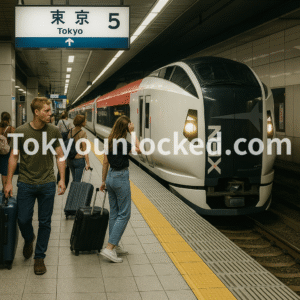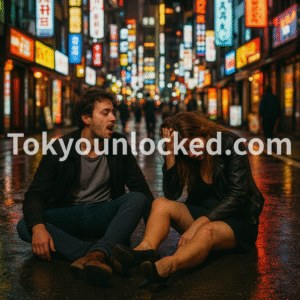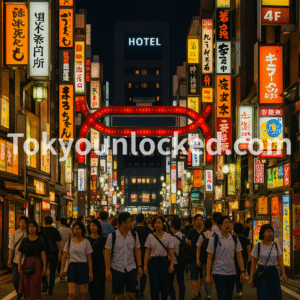Best Bars in Shinjuku: Local Nightlife Guide with Photos, Safety Tips & Hidden Gems
Thinking about exploring Shinjuku’s nightlife but unsure where to go—or if it’s even safe? As someone who has lived in Tokyo for over 10 years, I walked through Kabukicho at night, took real photos, and visited some of the best bars, speakeasies, and izakayas the area has to offer.
This guide shares everything you need: bar types, pricing, safety insights, and hidden spots just minutes from Shinjuku Station. Whether you’re arriving late, bar-hopping with friends, or looking for something more laid-back, there’s a place for you here.
I’ve grouped my picks by vibe—craft cocktails, lively locals, quiet corners—and included tips on what to expect, what to avoid, and how to get around.
Whether you’re visiting Tokyo for the first time or just want to skip the tourist traps, this guide was made to help you enjoy Shinjuku like a local.
Still looking for a hotel that’s close to all the action? Check out my Complete Guide to the Best Hotels in Shinjuku with walking-distance picks, pros & cons, and tips from a Tokyo local.
Is Shinjuku Safe at Night? What Travelers Need to Know

Shinjuku is one of Tokyo’s most vibrant districts—and also one of its most misunderstood. First-time visitors often ask the same question: Is Shinjuku actually safe at night? The short answer is yes—but with a few important caveats.
Let’s break it down by area. The West Exit and South Exit sides of Shinjuku Station, where you’ll find major hotels, department stores, and bus terminals, are extremely safe—even late at night. These areas are well-lit, busy, and patrolled regularly. I’ve walked there alone countless times at midnight or even 2 a.m., and never once felt unsafe. You’ll see business travelers, women walking solo, and tourists navigating with luggage well past midnight.
On the other hand, Kabukicho, accessed via the East Exit, is a different beast. It’s the largest red-light district in Japan, and while it’s not outright dangerous, it can feel overwhelming. After 10 p.m., especially around 2–4 a.m. when the bars close, you’ll see touts, host club promoters, and intoxicated patrons roaming the streets. Tokyo Metropolitan Police data shows that most petty crimes in Shinjuku—wallet theft, bar scams—happen in this area. That said, it’s also one of the most heavily surveilled zones in the city, with police boxes on every corner and security cameras installed across intersections.
Tips for staying safe: Stick to main roads like Yasukuni-dori or Kabukicho Ichibangai. Avoid entering bars or clubs without visible signage, clear pricing, or online reviews. Don’t engage with street promoters—just keep walking. If you’re unsure, drop into a FamilyMart or a chain café like Doutor and reassess. These places stay open late and are safe havens in the neon jungle.
For solo travelers—especially women—it’s worth planning your bar-hopping route ahead of time. Use Google Maps and read recent reviews. Shinjuku isn’t dangerous, but it is chaotic. Like Times Square in New York, it’s part show, part spectacle. You’ll be fine—as long as you’re alert.
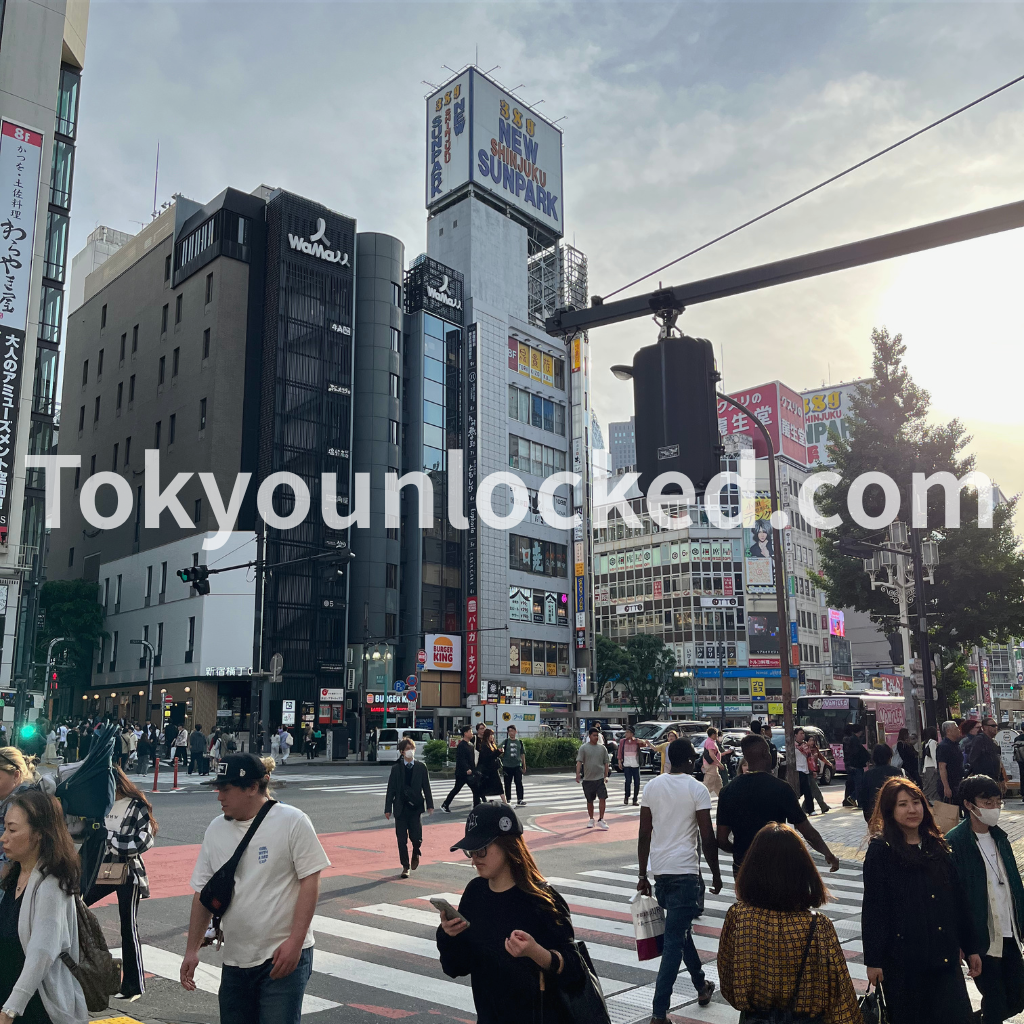
I visited Kabukicho and Golden Gai around 3:00 p.m. on a weekday to get a feel for the area in daylight. While the neon signs weren’t lit yet and the streets were quieter, you can still see the layout of the nightlife district before the crowds arrive. I captured the Godzilla head towering over the hotel and snapped a few shots of the narrow bar alleys while they were still empty. Scroll down to preview what the streets look like before the sun goes down—helpful if you’re planning a night out but want to scope the area first.
Where to Go – Top Nightlife Areas in Shinjuku

Shinjuku’s nightlife is chaotic, iconic, and deeply layered. The best part? You can walk between several nightlife zones in under 10 minutes. Whether you’re looking for high-energy bars, inclusive queer spaces, or old-school izakayas tucked into narrow alleys, Shinjuku has something for every mood—and every traveler.
This section breaks down the three main areas: Kabukicho, Ni-Chome, and Golden Gai / Omoide Yokocho. Each has a unique personality, crowd, and experience. If you’re new to Tokyo, this is where you should start mapping your night out.
Kabukicho – Bars, Host Clubs & Red-Light Culture
Kabukicho is often the first stop for nightlife in Tokyo – and for good reason. It’s loud, neon-lit, and filled with bars, karaoke joints, host clubs, and late-night eateries. The energy here is unmatched, but so is the chaos. If you’re looking for excitement, this is it.
That said, Kabukicho can be overwhelming for first-timers. Touts might approach you with flashy promises; some bars hide their prices; a few are outright scams.
But don’t be scared off – just be smart. Stick to venues with clear signage, online reviews, and visible menus. Chain bars and izakayas (like Torikizoku or HUB) are safe bets.
When I walked through Kabukicho at 3:00 p.m., the area was surprisingly calm. I snapped photos of bar entrances, hotel signs, and the famous Godzilla head – without the night crowd. It’s a good reminder: what feels chaotic at night is totally manageable by day.
Ni-Chome – LGBTQ+ Bars & Inclusive Vibes
Ni-Chome is Tokyo’s LGBTQ+ capital. Just a few blocks from Shinjuku Station, this area is home to over 300 gay bars, lesbian bars, drag lounges, and mixed venues. You don’t need to identify as LGBTQ+ to enjoy it – everyone is welcome, and the vibe is friendly and casual.
Bars here range from loud and party-focused to quiet and conversational. Some cater to locals only, but many welcome tourists – especially if you’re polite and buy a drink. There’s no pressure to dress up or “fit in.” It’s a place to relax, be yourself, and maybe even chat with the bartender for tips on other spots.
My personal visit to a Reddit-recommended mixed bar felt like stumbling into someone’s living room. Small, friendly, and safe.
If you’re looking for an inclusive, low-key vibe, Ni-Chome is a must-stop.
Golden Gai & Omoide Yokocho – Nostalgic Izakaya Streets
If you’re chasing old-school Japan after dark, head to Golden Gai and Omoide Yokocho. These compact, alley-like bar districts are straight out of a movie – tiny wooden bars, handwritten menus, five seats max.
Golden Gai is more nightlife-focused: themed bars, expat-friendly joints, and late-night characters. Omoide Yokocho leans food-first – yakitori smoke, clinking beer glasses, and locals chatting shoulder-to-shoulder. English may not be spoken everywhere, but staff are used to tourists and will often welcome you with a smile and a “kanpai.”
I visited both on a quiet weekday afternoon and took photos of the lanterns, signs, and bar names. Seeing the space in daylight helped me map out which bars to try that night – and which ones had the best energy.
Best Bars in Shinjuku: Local Picks by Type
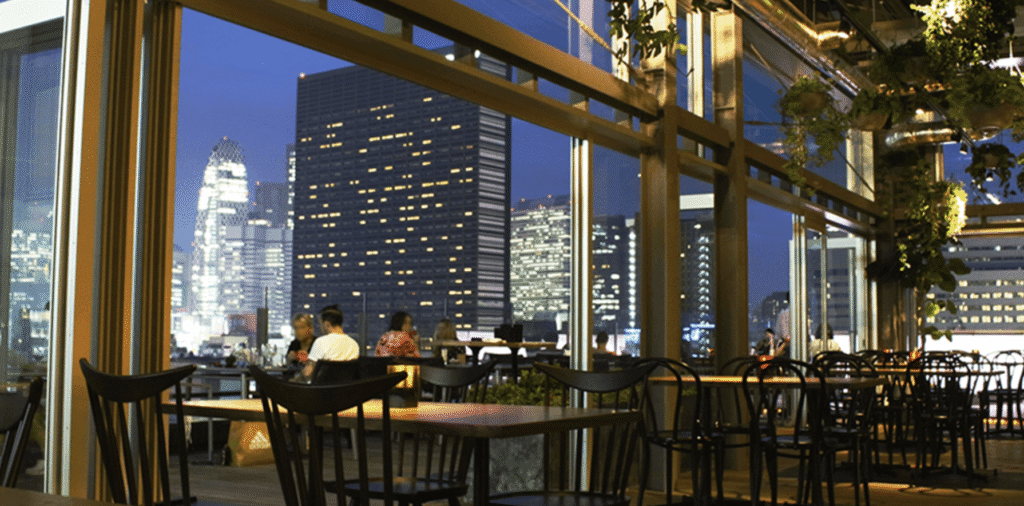
Shinjuku has too many bars – which is exactly why picking the right one matters. Whether you’re into hidden speakeasies, rooftop skyline views, carefully crafted cocktails, or local izakaya vibes, this section breaks it down by type so you can match your mood, budget, and taste.
All picks are based on personal visits, local advice, and community recommendations—not sponsored or paid placements.
Hidden Speakeasies & Secret Entrances
If you love the thrill of “finding the unfindable,” Shinjuku has a growing scene of speakeasies and hidden bars tucked behind sliding doors, vending machines, or down unmarked staircases. These places don’t scream for attention—they whisper style.
Some favorites include bars where you enter through a janitor’s closet or need a code from Instagram DMs. The vibe? Quiet jazz, low lighting, and bartenders who remember your drink. These spots aren’t cheap, but the experience is worth it.
On a weekday afternoon, I photographed a few of these hidden entrances—bare doors, no signage, just a tiny bell or lantern. It’s like a treasure hunt, and that’s half the fun.
Rooftop Bars with a View
Want to escape the street noise and drink above the city lights? Rooftop bars are Shinjuku’s underrated gem. Places like the Granbell Hotel rooftop bar offer stylish open-air seating, skyline views, and signature cocktails without the usual crowds.
I went up just before sunset – it was quiet, breezy, and surprisingly relaxed. Great for dates, solo travelers, or anyone needing a pause from the chaos below. Some rooftops charge a cover; others just require a drink order.
Trendy Cocktail Bars for Visitors
Prefer bartenders in vests, hand-cut ice, and drinks you can’t pronounce? You’re in luck. Bars like Ben Fiddich, Bar Orchard, and newer spots in East Shinjuku blend world-class mixology with a chill Tokyo aesthetic.
These places often cater to tourists – English menus, friendly staff, and no fuss if you don’t know what to order. I visited one recommended by a local: the bartender asked two questions and served me one of the best herbal gin cocktails I’ve ever had.
Expect to spend ¥1,200–¥2,000 per drink. It’s not cheap, but it’s a treat worth the budget.
Authentic Izakayas in Golden Gai & Yokocho
Sometimes you just want cheap beer, grilled meat, and a local crowd – that’s what izakayas in Golden Gai and Omoide Yokocho deliver. No pretense, no dress code – just stools, smoke, and stories.
Many places seat fewer than 10 people, but that’s the charm. You might meet a salaryman, a fellow traveler, or a bartender who’s run the place for 30 years. Menus are often in Japanese, but pointing and smiling gets you far.
Late-Night Food in Shinjuku: Ramen, Sushi & Yakiniku
No matter how good the drinks are, every Tokyo night needs a great ending – and in Shinjuku, that usually means food. Whether you’re stumbling out of Golden Gai or wrapping up rooftop cocktails, Shinjuku is built for late-night eats.
Best Ramen Shops Open Past Midnight
Shinjuku is ramen paradise. The big names like Ichiran and Menya Nagi stay open well past 3 a.m., serving tourists and locals alike. They’re convenient, consistent, and have English menus—which is why they’re always packed.
But if you want something different—less touristy, more local—try Takahashi Grilled Flying Fish Salt Ramen (Shinjuku Main Branch). I went there around 1:00 a.m. The soup had a deep, smoky flavor, and the staff didn’t flinch when I walked in solo. It’s calm, fragrant, and flavorful.
Takahashi Grilled Flying Fish Salt Ramen, Shinjuku Main Branch
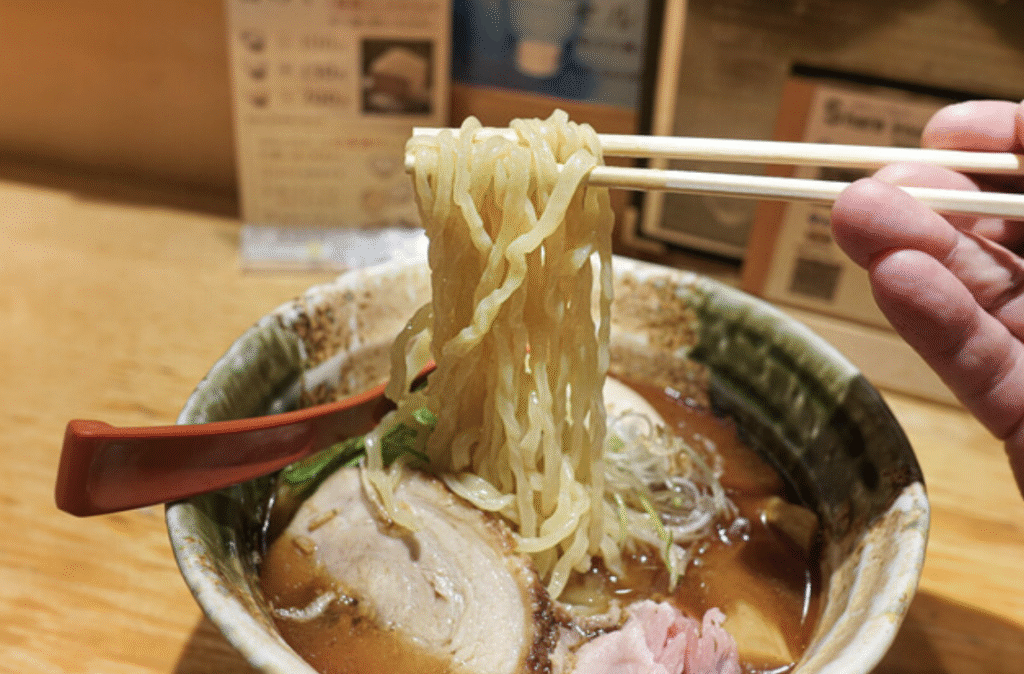
Incredibly fragrant flying fish soup stock✨
”I ordered the ramen without back fat.
The soup had a savory aroma like burnt dried sardines, and I could taste the deliciousness of the fish! There
were three types of pork slices, which shows the store’s commitment, and each one had a different flavor, so it was fun to try different flavors.
There were also condiments on the table, such as rice crackers, wasabi, and yuzu pepper, so you could enjoy changing the flavor of the soup.
It was a bowl of ramen that was very rich, but easy to eat, and very delicious.”
All-Night Yakiniku & Sushi
Sometimes noodles won’t cut it – you want meat. Shinjuku has several all-night yakiniku joints, where you can grill wagyu at 2:00 a.m. in a room full of night owls. I once ate solo yakiniku at 1:30 a.m. with 4 other people doing the same. No judgment, just the smell of sizzling beef.
Craving sushi instead? Sushi Zanmai, just a few blocks from the station, runs late and serves high-quality cuts at decent prices. It’s not fancy, but it hits the spot after a long night. (You can see iconic of the picture of Sushi Zanmai’s president)
Cheap & Tasty Eats Near the Station
Let’s not underestimate Japan’s ultimate late-night savior: the konbini.
7-Eleven, FamilyMart, and Lawson stock solid meals 24/7 – bento boxes, cold noodles, onigiri, even curry rice.
I grabbed a hot tamago sandwich and green tea from Lawson at 3:15 a.m. It cost under 500 yen and kept me alive until breakfast.
If you’re on a budget or just want a quick bite before catching the first train, convenience stores around Shinjuku Station are lifesavers.
Shinjuku vs Shibuya: Which Nightlife Hub Fits You Best?
Shinjuku and Shibuya are Tokyo’s two nightlife giants. Tourists often ask: Which one is better for a night out? The truth? It depends on your vibe.
Here’s a breakdown from someone who’s partied in both – multiple times, and at all hours.
Vibe and crowd differences
Shinjuku is raw, chaotic, and incredibly diverse. You’ll find host clubs, dive bars, red-light culture, LGBTQ+ spots, and gritty alleys all within a few blocks. The crowd? Locals, office workers, nightlife veterans, and plenty of curious tourists.
Shibuya, on the other hand, is younger, trendier, and more club-oriented. Think DJs, cocktail bars, and fashion-forward crowds. It’s sleek, a bit polished, and designed for group fun or flashy nights out.
If you’re into street-level exploration, smoky izakayas, and “let’s see where the night takes us” energy—Shinjuku wins. If you want clubbing, bar-hopping with your crew, or just a clean, easy-going vibe, head to Shibuya.
Budget, Drink Prices & Cover Charges
Shibuya is typically more expensive—cocktails run ¥1,200–¥2,000, and clubs often charge ¥2,000–¥4,000 for entry (sometimes with a drink included). Dress codes aren’t always strict, but stylish attire is common.
Shinjuku has more range. You can drink in a Golden Gai bar for ¥700 a beer, or head to a rooftop lounge and spend more—but it’s flexible. Izakayas don’t charge covers, and there are no bouncers telling you how to dress.
Local Tip: Shibuya might “look safer,” but Shinjuku is often friendlier—especially when you engage with bar owners or locals.
Navigation & First-Time Friendliness
Shibuya is easy to navigate. The nightlife zones (like Dogenzaka) are compact, maps work well, and there are fewer “sketchy” streets. It’s great for people who want minimal confusion.
Shinjuku is harder to read—alleyways, aggressive touts, and endless options can be overwhelming. But that’s also what makes it thrilling. You’ll get lost once or twice, but you’ll also find something unforgettable.
So, Which Should You Choose?
- Go Shibuya if: You want clubs, flash, easy access, and group partying.
- Go Shinjuku if: You want diversity, authentic experiences, solo bar-hopping, or a little bit of chaos.
I personally take first-time visitors to both—but the best stories always come from nights that started in Shinjuku.
Tokyo Local’s Walkthrough: A Night in Kabukicho
If you’ve read about Kabukicho online, you’ve probably seen all kinds of opinions – from wild party stories to overblown warnings. So I decided to check it out again myself.
I’ve lived in Tokyo for over 10 years, but this time, I walked Kabukicho with fresh eyes – at 3:00 p.m. on a weekday, camera in hand, to see how the place feels before it transforms into the neon beast it becomes at night.
And honestly? It was surprisingly quiet. The iconic Godzilla head loomed over the Toho building like always, but there were no touts, no crowds, just a few tourists posing for photos and locals going about their day. I photographed narrow bar alleys while the shutters were still down, and host club signs before the lights came on.

Walking Kabukicho during the day gives you a strategic edge. You can map out bars you might want to try later, figure out which alleys are too sketchy, and spot places with clear signage and pricing.
If you’re a first-time visitor or a solo traveler, I recommend doing a daylight walk just like this.
Of course, the real energy of Kabukicho kicks in after 9 p.m. – that’s when the area turns electric. But doing your homework first makes it feel far less intimidating when the neon starts to glow.
So if you’re wondering whether Kabukicho is too much for you… try walking it when the sun’s still up. You might be surprised how manageable, and even welcoming – it can feel.
FAQ: Safety, LGBTQ+ Spots, Late Hours & More
Is Kabukicho safe for women at night?
Yes, generally – but some precautions help. Stick to main roads like Yasukuni-dori or Kabukicho Ichibangai, avoid talking to street touts, and don’t enter bars without visible pricing or signage. Many women, both local and foreign, walk through Kabukicho alone, especially before midnight. As always, trust your instincts – if something feels off, head to a konbini or well-known café to regroup.
Where can I find LGBTQ+ bars in Tokyo?
Head to Ni-Chome in Shinjuku. It’s Tokyo’s LGBTQ+ nightlife hub. With over 300 bars, you’ll find everything from tiny local spots to large mixed venues with English menus. Some bars cater to specific communities, but most are welcoming if you’re respectful and order a drink. Look for directories like Stonewall Japan or use Google Maps with recent reviews.
Are bars in Shinjuku open all night?
Some are, especially izakayas and ramen shops. Most standard bars close between 2–4 a.m., but you’ll find 24-hour restaurants, convenience stores, and even sushi spots near the station that stay open till sunrise. Golden Gai usually wraps up earlier than Kabukicho.
Which is better for nightlife: Shibuya or Shinjuku?
Shibuya is more accessible, polished, and club-focused, great for first-timers or trend-seekers. Shinjuku is more chaotic, diverse, and raw – ideal for bar-hoppers and those who want something “only in Tokyo.” If you’re down for a bit of unpredictability and lots of character, Shinjuku wins hands down.


